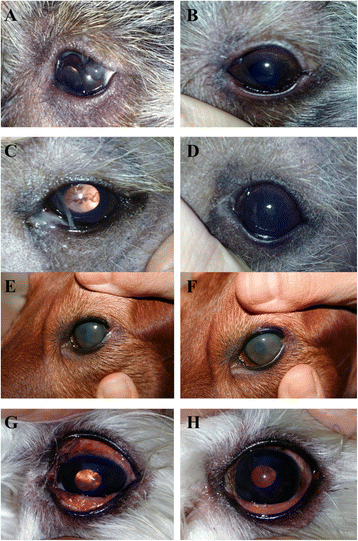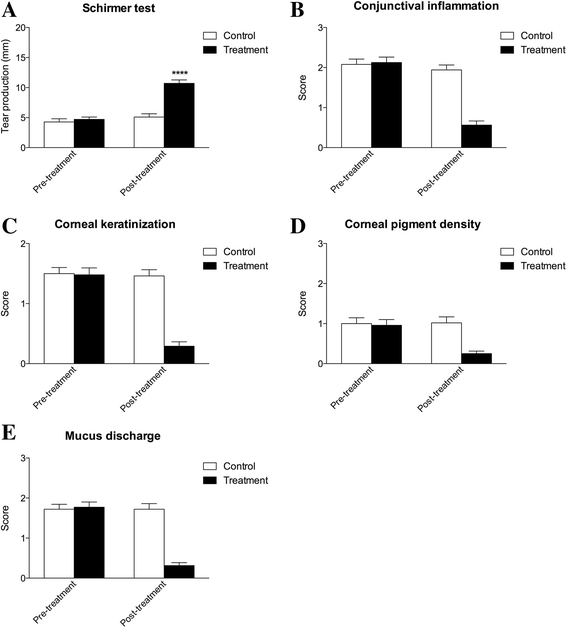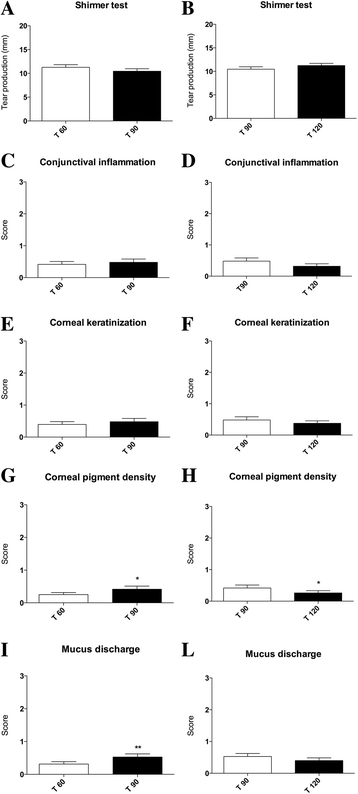Clinical evaluation of a nutraceutical diet as an adjuvant to pharmacological treatment in dogs affected by Keratoconjunctivitis sicca
- PMID: 27658509
- PMCID: PMC5034585
- DOI: 10.1186/s12917-016-0841-2
Clinical evaluation of a nutraceutical diet as an adjuvant to pharmacological treatment in dogs affected by Keratoconjunctivitis sicca
Erratum in
-
Erratum to: Clinical evaluation of a nutraceutical diet as an adjuvant to pharmacological treatment in dogs affected by Keratoconjunctivitis sicca.BMC Vet Res. 2016 Dec 5;12(1):273. doi: 10.1186/s12917-016-0848-8. BMC Vet Res. 2016. PMID: 27919262 Free PMC article. No abstract available.
Abstract
Background: Canine keratoconjunctivitis sicca (cKCS) is an inflammatory eye condition related to a deficiency in the tear aqueous fraction. Etiopathogenesis of such disease is substantially multifactorial, combining the individual genetic background with environmental factors that contribute to the process of immunological tolerance disruption and, as a consequence, to the emergence of autoimmunity disease. In this occurrence, it is of relevance the role of the physiological immune-dysregulation that results in immune-mediated processes at the basis of cKCS. Current therapies for this ocular disease rely on immunosuppressive treatments. Clinical response to treatment frequently varies from poor to good, depending on the clinical-pathological status of eyes at diagnosis and on individual response to therapy. In the light of the variability of clinical response to therapies, we evaluated the use of an anti-inflammatory/antioxidant nutraceutical diet with potential immune-modulating activity as a therapeutical adjuvant in cKCS pharmacological treatment. Such combination was administered to a cohort of dogs affected by cKCS in which the only immunosuppressive treatment resulted poorly responsive or ineffective in controlling the ocular symptoms.
Results: Fifty dogs of different breeds affected by immune-mediated cKCS were equally distributed and randomly assigned to receive either a standard diet (control, n = 25) or the nutraceutical diet (treatment group, n = 25) both combined with standard immunosuppressive therapy over a 60 days period. An overall significant improvement of all clinical parameters (tear production, conjunctival inflammation, corneal keratinization, corneal pigment density and mucus discharge) and the lack of food-related adverse reactions were observed in the treatment group (p < 0.0001).
Conclusions: Our results showed that the association of traditional immune-suppressive therapy with the antioxidant/anti-inflammatory properties of the nutraceutical diet resulted in a significant amelioration of clinical signs and symptoms in cKCS. The beneficial effects, likely due to the presence of supplemented nutraceuticals in the diet, appeared to specifically reduce the immune-mediated ocular symptoms in those cKCS-affected dogs that were poorly responsive or unresponsive to classical immunosuppressive drugs. These data suggest that metabolic changes could affect the immune response orchestration in a model of immune-mediated ocular disease, as represented by cKCS.
Keywords: Antioxidant and anti-inflammatory diet; Immune-mediated ocular disease; Keratoconjunctivitis sicca; Nutraceutical diet.
Figures



Similar articles
-
Use of episcleral cyclosporine implants in dogs with keratoconjunctivitis sicca: pilot study.Vet Ophthalmol. 2015 May;18(3):234-41. doi: 10.1111/vop.12173. Epub 2014 May 5. Vet Ophthalmol. 2015. PMID: 24799029
-
Clinical and light microscopic studies of the conjunctival tissues of dogs with bilateral keratoconjunctivitis sicca before and after treatment with topical 2% cyclosporine.Biotech Histochem. 2015 Apr;90(3):223-30. doi: 10.3109/10520295.2014.930177. Epub 2015 Mar 6. Biotech Histochem. 2015. PMID: 25747049
-
Treatment of keratoconjunctivitis sicca in dogs with cyclosporine ophthalmic ointment: a European clinical field trial.Vet Rec. 1995 Nov 11;137(20):504-7. doi: 10.1136/vr.137.20.504. Vet Rec. 1995. PMID: 8588275 Clinical Trial.
-
[Keratoconjunctivitis sicca (KCS) in dogs].Tijdschr Diergeneeskd. 2005 Nov 15;130(22):703-4. Tijdschr Diergeneeskd. 2005. PMID: 16335151 Review. Dutch. No abstract available.
-
Immunopathogenesis of keratoconjunctivitis sicca in the dog.Vet Clin North Am Small Anim Pract. 2008 Mar;38(2):251-68, vi. doi: 10.1016/j.cvsm.2007.12.002. Vet Clin North Am Small Anim Pract. 2008. PMID: 18299006 Review.
Cited by
-
Extender Supplementation with Glutathione (GSH) and Taurine Improves In Vitro Sperm Quality and Antioxidant Status of New Zealand Rabbits during Chilled Storage for up to 72 hours.Vet Med Int. 2023 Sep 12;2023:8339591. doi: 10.1155/2023/8339591. eCollection 2023. Vet Med Int. 2023. PMID: 37732161 Free PMC article.
-
Effects in dogs with behavioural disorders of a commercial nutraceutical diet on stress and neuroendocrine parameters.Vet Rec. 2017 Jan 7;180(1):18. doi: 10.1136/vr.103865. Epub 2016 Nov 24. Vet Rec. 2017. PMID: 27885066 Free PMC article. Clinical Trial.
-
Zinc Oxide Nanoparticles (ZnO-NPs) Induce Cytotoxicity in the Zebrafish Olfactory Organs via Activating Oxidative Stress and Apoptosis at the Ultrastructure and Genetic Levels.Animals (Basel). 2023 Sep 9;13(18):2867. doi: 10.3390/ani13182867. Animals (Basel). 2023. PMID: 37760268 Free PMC article.
-
Astaxanthin Mitigates Thiacloprid-Induced Liver Injury and Immunotoxicity in Male Rats.Mar Drugs. 2021 Sep 18;19(9):525. doi: 10.3390/md19090525. Mar Drugs. 2021. PMID: 34564187 Free PMC article.
-
Effects of Heat-Induced Oxidative Stress and Astaxanthin on the NF-kB, NFE2L2 and PPARα Transcription Factors and Cytoprotective Capacity in the Thymus of Broilers.Curr Issues Mol Biol. 2024 Aug 22;46(8):9215-9233. doi: 10.3390/cimb46080544. Curr Issues Mol Biol. 2024. PMID: 39194761 Free PMC article.
References
-
- Lemp MA. Report of the national eye institute/industry workshop on clinical trials in dry eyes. CLAO J. 1995;21(4):221–232. - PubMed
MeSH terms
Substances
LinkOut - more resources
Full Text Sources
Other Literature Sources
Medical

